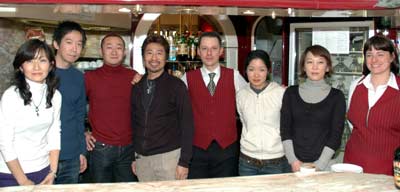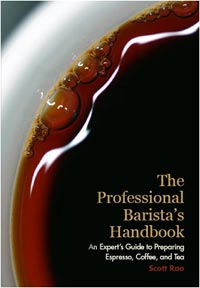by Luigi Odello
Secretary General of the International Institute of Coffee Tasters, he is also a lecturer at the University of Udine, Verona and at the Cattolica in Piacenza. In addition he is the Chairman of the Taster Study Center and Secretary General of the Italian Espresso National Institute
 Without competition, there can be no improvement. This is a genetics law but it is true also for the business world. However, many companies in the coffee sector are not that keen on competition, especially if it is on the sensory impact of the blends. Think about wine, a product from which coffee should draw inspiration if it wants to a step further towards the life of consumers. There is an incredible number of guides with all sorts of comments – expressed in differing ways – valuations at exaggerated rhythms and competitions with tens of editions left behind.
Without competition, there can be no improvement. This is a genetics law but it is true also for the business world. However, many companies in the coffee sector are not that keen on competition, especially if it is on the sensory impact of the blends. Think about wine, a product from which coffee should draw inspiration if it wants to a step further towards the life of consumers. There is an incredible number of guides with all sorts of comments – expressed in differing ways – valuations at exaggerated rhythms and competitions with tens of editions left behind.
In our business, the International Institute of Coffee Tasters has recently finalised an unprecedented investigation on quality at the bar: 907 surveys in bars in the entire Italian territory, 20 bars in he city centre of Milan and Rome examined by means of the environment and sensory analysis.
On the one hand, the joy of the winners has been expressed in quiet tones, on the other, the anger of the excluded has been strong to the extent that the poorly appeased acrimony reached the governing bodies of major institutions. We should be happy about this because it is anyhow a reaction which means that something will happen. We would like this to turn into food for thought for everybody on what to do to improve rather than to boil down to plain expression of sorrow.
These are our thoughts while we are busy with the organisation of another big event at an International level: the second edition of International Coffee Tasting. The first edition, in 2006, was a success. Not only in terms of the number of attendees. Some companies bought entire pages on newspapers to advertise the award they won. Other participants asked if it was possible to display the logo of the competition on their product. Let alone the company that received an order of coffee from a big Dutch agent in order to supply 5000 families with the gold medal product.
International Coffee Tasting is the first and only competition in the world of this kind. Its rules are based on the strict rules applied to wine tasting and defined by the International Organisation of Vines and Wine. Expert tasters from the International Institute of Coffee Tasters taste, anonymously, the coffee and the data is processed with the support of the most modern statistics techniques.
What else can be done? Well, we are already aware that the anger of the excluded will show once again.
 Recently, I hosted in my coffee shop some Japanese baristas who were accompanied by the infaillibly efficient Yumiko Momoi – the secretary general of the International Institute of Coffee Tasters for Japan. We spent a few hours together in my coffee shop. This was a great occasion for speaking about espresso and cappuccino and for working together at the espresso machine. Actually, Chihiro Yokoyama – a colleague who won several times the Japanese Barista Championship – was there with the group. First thought: all the baristas had an in-depth and specific knowledge of the entire coffee production process. Put it more clearly: they know what sort of processing the product they use every day went through. They’ve got clear views on the differences between the species, between the various ways of processing green beans and so on. This is not irrelevant: you can make the most of a semi-processed product such as coffee is only with a deep knowledge of how it is processed. This makes it possible to extract its specific sensory characteristics.
Recently, I hosted in my coffee shop some Japanese baristas who were accompanied by the infaillibly efficient Yumiko Momoi – the secretary general of the International Institute of Coffee Tasters for Japan. We spent a few hours together in my coffee shop. This was a great occasion for speaking about espresso and cappuccino and for working together at the espresso machine. Actually, Chihiro Yokoyama – a colleague who won several times the Japanese Barista Championship – was there with the group. First thought: all the baristas had an in-depth and specific knowledge of the entire coffee production process. Put it more clearly: they know what sort of processing the product they use every day went through. They’ve got clear views on the differences between the species, between the various ways of processing green beans and so on. This is not irrelevant: you can make the most of a semi-processed product such as coffee is only with a deep knowledge of how it is processed. This makes it possible to extract its specific sensory characteristics.
 The Professional Barista’s Handbook is an interesting attempt by Scott Rao – American consultant in the USA coffee business – to provide a 360° view on the art of being a barista. “When, 14 years ago, I started working in the business I used to read each and every available book on coffee I could find – says Rao in the introduction. After having read all these books, I was left with the impression that I had not learned so much on how to prepare a great coffee”. In a few words: there was no book with the most relevant and down-to-earth hints for a barista. Given that he could not find any, Rao decided to write one himself with the aim of producing the first truly exhaustive manual for a barista. No doubt that this is a book which covers everything and each topic is dealt with in great detail: percolation, dosing, the methods for levelling the ground coffee in the filter-holder, pressing and, it goes without saying, everything which has got to do with preparing an espresso (more than that: there is also a chapter on tea). The author makes a thorough description with continual reference to scientific research, data and numbers. However, sometimes, Rao suffers from excess of zeal and proposes solutions which could be deemed, quite rightly, a bit complicated and the usefulness of which could be legitimately questioned. If we neglect some overdoing here and there, Rao’s book is a good quality guide. Indeed, it is a collection of most of the things a barista should know if s/he wants to define her/himself a real professional barista.
The Professional Barista’s Handbook is an interesting attempt by Scott Rao – American consultant in the USA coffee business – to provide a 360° view on the art of being a barista. “When, 14 years ago, I started working in the business I used to read each and every available book on coffee I could find – says Rao in the introduction. After having read all these books, I was left with the impression that I had not learned so much on how to prepare a great coffee”. In a few words: there was no book with the most relevant and down-to-earth hints for a barista. Given that he could not find any, Rao decided to write one himself with the aim of producing the first truly exhaustive manual for a barista. No doubt that this is a book which covers everything and each topic is dealt with in great detail: percolation, dosing, the methods for levelling the ground coffee in the filter-holder, pressing and, it goes without saying, everything which has got to do with preparing an espresso (more than that: there is also a chapter on tea). The author makes a thorough description with continual reference to scientific research, data and numbers. However, sometimes, Rao suffers from excess of zeal and proposes solutions which could be deemed, quite rightly, a bit complicated and the usefulness of which could be legitimately questioned. If we neglect some overdoing here and there, Rao’s book is a good quality guide. Indeed, it is a collection of most of the things a barista should know if s/he wants to define her/himself a real professional barista. Without competition, there can be no improvement. This is a genetics law but it is true also for the business world. However, many companies in the coffee sector are not that keen on competition, especially if it is on the sensory impact of the blends. Think about wine, a product from which coffee should draw inspiration if it wants to a step further towards the life of consumers. There is an incredible number of guides with all sorts of comments – expressed in differing ways – valuations at exaggerated rhythms and competitions with tens of editions left behind.
Without competition, there can be no improvement. This is a genetics law but it is true also for the business world. However, many companies in the coffee sector are not that keen on competition, especially if it is on the sensory impact of the blends. Think about wine, a product from which coffee should draw inspiration if it wants to a step further towards the life of consumers. There is an incredible number of guides with all sorts of comments – expressed in differing ways – valuations at exaggerated rhythms and competitions with tens of editions left behind.
